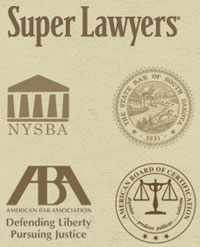Gaze over your shoreline property knowing that you can access the waters directly in front of you. Unfortunately, under New York law, depending on the shape of the shoreline and how lot boundaries are drawn, this may not be the case. New York courts use different principles and their own discretion in determining the reach of landowners’ riparian rights.
In Muraca v. Meyerowitz, 13 Misc. 3d 348, 350 (Sup. Ct. 2006), three adjacent riparian landowners disputed each others riparian water rights boundaries primarily because one of the party’s private boat occupied a large portion of surface waters near the shore.
Under New York law, riparian rights only arise from the ownership of land abutting or surrounding a body of water, such as a lake or a pond as long as there is contact between water and the land. In Muraca, the Court recognized that riparian landowner rights extend out to the navigable portion of the water body, but go no further. A riparian owner has the right to access water and the related right to protect the water from illegal drawing of the water as well as the right to build out to the water by way of a dock, slip or pier.
When a controversy concerning riparian rights arises, the resolution sought is access to water from shoreline properties. How to determine the rights of access between riparian landowners is complex.
In New York there are no mechanical rules used to draw the lateral boundaries between riparian landowners. Rather, courts strive to give an equitable allocation of the waterfront area, with the right of access depending on the frontage available to the landowner based on the lateral boundaries of their properties.
The Muraca court explains that two principal formulas have been derived for establishing lateral boundaries in the context of landowner’s riparian rights.
First, the “perpendicular rule” extends the lateral onshore boundaries out to the navigable body of water by lines that are perpendicular to the shoreline. This principle is equitable when there are only minor shoreline irregularities (i.e. a straight onshore boundary).
Second, the “proportional method” attempts to draw a path between onshore boundaries that are proportionate to the amount of frontage the landowners enjoys. When choosing a method or modifying a rule, a court will consider a landowner’s right to direct access to navigable waters along with their neighbor’s right of direct access.
So it is not just one’s right of access to navigable waters that matter when resolving such controversies, but rather what in fact matters are one’s riparian rights in relation to one’s neighbors.
There are limits attached to these general principals. A riparian owner must remember that he is always subject to the restrictions to which he agreed when he purchased the property. Outside of these contractual or deed restrictions, riparian landowners cannot extend their “upland boundaries”, or the boundary above the mean high tide line, to form the lateral boundaries of the land under the water. This limit however is not all encompassing. New York courts have recognized that a riparian owner’s right to the natural flow of water along its land is properly classified as real property, equally with the land. A party could nevertheless acquire an interest in the water flow separate and distinct from the land under the water.
In Muraca the Court found the proportionate rule inapplicable and modified the perpendicular rule because strictly applying the perpendicular rule would have unfairly reduced the defendants’ right to access their outshore surface waters.
Ironically, even though the boat owner was given more riparian rights to access the outshore waters in front of his property than the complaining plaintiff requested, the Court found the party’s ability to dock his 28 foot boat to be of little consequence. The riparian rights boundaries only have to be sufficient enough to accommodate reasonably sized watercraft.
The implications of a court determining the riparian boundary lines based on general principles of equity is memorable.
First, it suggests that a court can alter your deed if you eventually find yourself in litigation over the riparian rights of yourself and other riparian landowners.
Second, and perhaps more importantly, under New York law, when riparian real property increased by “accretion”, or the gradual addition of property along a shoreline, then new formed land belongs to the upland landowner. However, if the riparian boundary lines are altered as the court did in Muraca, then the new lands normally entitled to riparian landowner will go to their neighbor.
David Ganje practices law in the area of natural resources, environmental and commercial law.





